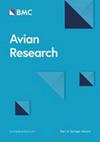机会性食虫性欧洲食蜂的亲鸟和雏鸟食物变化
IF 1.6
2区 生物学
Q1 ORNITHOLOGY
引用次数: 0
摘要
与开阔栖息地相关的古北欧食虫鸟类依赖大量的猎物,但由于栖息地的丧失和密集的农业耕作,这些猎物目前正在减少。欧洲食蜂鸟(Merops apiaster)是开阔栖息地的机会主义食虫鸟类,主要捕食中型到大型飞虫。它的食物组成过去曾受到过一些关注,但目前人们对不同栖息地繁殖的鸟类以及成鸟和雏鸟之间食物组成的变化仍然知之甚少。在这项研究中,我们确定了伊比利亚半岛五种常见栖息地的食蜂鸟群的食物变化。我们还评估了雏鸟和成鸟食物组成的差异,并调查了成鸟的季节性食物选择性。最后,我们还探讨了雏蜂在整个生长期中捕食猎物大小的变化。膜翅目和鞘翅目是食蜂最重要的食物种类,成蜂和雏蜂分别摄食58.8%和64.1%的膜翅目昆虫,37.6%和28.6%的鞘翅目昆虫。在牧场和橡树栖息地的蜂群中,膜翅目(42.3-55.7%)和鞘翅目(43.3-53.5%)占食物的比例相似,但在草甸和混交林蜂群中,膜翅目占主导地位(83.8%和95.7%)。尽管成年食蜂鸟通常是机会主义捕食者,但在雏鸟成长过程中,它们会为后代提供越来越多的大型昆虫。此外,即使膜翅目昆虫和鞘翅目昆虫的数量季节性减少,食蜂也同样为自己和雏鸟捕食这些昆虫。总之,这些结果表明,与特定栖息地相关的当地猎物可用性会影响食性组成,因此,某些类群的区域性减少可能会根据食性和栖息地偏好对食虫动物物种产生不同的影响。本文章由计算机程序翻译,如有差异,请以英文原文为准。
Variation of parental and chick diet in opportunistic insectivorous European Bee-eaters
Insectivorous Palaearctic bird species associated with open habitats rely on high prey abundances, which are currently declining due to habitat loss and intensive agricultural practices. The European Bee-eater (Merops apiaster) is an opportunistic insectivore of open habitats, preying mainly on medium to large-sized flying insects. Its diet composition received some attention in the past, but the current variation in diet composition of birds breeding across different habitats, and between adults and chicks remains poorly known. In this study, we determine variation in bee-eaters’ diet in colonies located in five common habitats at the Iberian Peninsula. We also assess differences in the diet composition of chicks and adults and investigate seasonal diet selectivity of adults. Finally, we explore the variability in the size of prey provided to chicks throughout their growth period. Hymenoptera and Coleoptera were the most important groups for bee-eaters, with adults and chicks consuming 58.8% and 64.1% of hymenopterans and 37.6% and 28.6% of coleopterans, respectively. The proportion of Hymenoptera (42.3–55.7%) and Coleoptera (43.3–53.5%) in the diet was similar in colonies in pasture and oak habitats, but Hymenoptera dominated (83.8% and 95.7%) in meadow and mixed forest colonies. Despite being a generally opportunistic predator, adult bee-eaters provide their progeny with an increasing proportion of larger insects through chick development. Moreover, they equally take Hymenoptera and Coleoptera for themselves and their chicks, even when the abundance of these insects decreases seasonally. Overall, these results suggest that local prey availability associated with specific habitats influences diet composition and that regional declines in certain groups may, therefore, affect insectivore species differently according to their dietary and habitat preferences.
求助全文
通过发布文献求助,成功后即可免费获取论文全文。
去求助
来源期刊

Avian Research
ORNITHOLOGY-
CiteScore
2.90
自引率
16.70%
发文量
456
审稿时长
46 days
期刊介绍:
Avian Research is an open access, peer-reviewed journal publishing high quality research and review articles on all aspects of ornithology from all over the world. It aims to report the latest and most significant progress in ornithology and to encourage exchange of ideas among international ornithologists. As an open access journal, Avian Research provides a unique opportunity to publish high quality contents that will be internationally accessible to any reader at no cost.
 求助内容:
求助内容: 应助结果提醒方式:
应助结果提醒方式:


